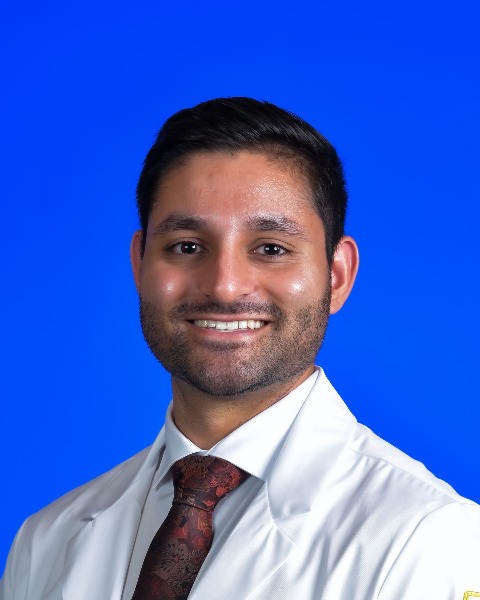Tuesday Poster Session
Category: IBD
P5500 - Pseudomembranous Colitis With Underlying Inflammatory Bowel Disease in a Toxin-Negative Case
Tuesday, October 28, 2025
10:30 AM - 4:00 PM PDT
Location: Exhibit Hall

Yash S. Patil (he/him/his)
Touro University Nevada
Henderson, NV
Presenting Author(s)
Yash S. Patil, 1, Scott Diamond, DO2, Harish Venkat, 3, Faraaz Meher, 4
1Touro University Nevada, Henderson, NV; 2Utah Gastroenterology, St. George, UT; 3Touro University Nevada, Union City, CA; 4Touro University Nevada, Silver Spring, MD
Introduction: Clostridioides difficile infections (CDI) in IBD patients pose diagnostic challenges due to symptom overlap and immunosuppression. Standard CDI testing involves screening for glutamate dehydrogenase, which does not distinguish toxigenic from nontoxigenic strands; or nucleic acid amplification testing (NAAT) for toxigenic strands. This is followed by toxin A/B enzyme immunoassay (EIA) for active toxin production. A positive NAAT and negative toxin EIA indicates colonization without infection, however, in high-risk patients, these results may reflect true CDI.
Case Description/
Methods: A 25-year-old male with recurrent nephrolithiasis was admitted for pyelonephritis. He had two years of intermittent watery, non-bloody diarrhea worsening over five days which had not previously been evaluated. His mother has ulcerative colitis. Labs showed leukocytosis, elevated creatinine, and elevated fecal calprotectin (1710 μg/g). C. Difficile NAAT was positive with a negative toxin EIA. CT abdomen with IV contrast showed colonic thickening and fat stranding in the cecum, descending, and sigmoid colon. Colonoscopy showed pancolitis with white pseudomembranes throughout. Segmental biopsies showed chronic moderately active colitis from the ascending to sigmoid colon consistent with pseudomembranous colitis with underlying IBD. He was treated with oral vancomycin 125 mg QID for 14 days with fecal microbiota transplant (FMT) two days post-treatment.
Discussion: This case highlights the limitations of positive NAAT/negative toxin EIA in diagnosing CDI in IBD. NAAT has a high sensitivity to specificity ratio (95–96% to 94–98%). Toxin EIA is more specific (57–83% to 99%), however, with higher false negative rates (17–43%)¹. In IBD patients, false positive toxin EIAs occur 21% more than in non-IBD patients, due to mucosal inflammation and microbiota disruption². IBD patients with CDI have higher risks of recurrence (33%¹), toxic megacolon, and severe and fulminant disease than those without IBD. Hospitalized IBD patients with CDI have a four times higher mortality rate than those with CDI or IBD alone³. A prolonged treatment course with vancomycin for 14 days reduces recurrence likelihood in IBD patients versus a standard 10-day course¹. Fidaxomicin is also likely effective despite limited evidence. FMT within 2-4 days is advised to prevent CDI recurrences and restore gut microbiome in IBD¹. Understanding testing and treatment discrepancies in IBD-related CDI is crucial to prevent complications and optimize outcomes.
Disclosures:
Yash Patil indicated no relevant financial relationships.
Scott Diamond indicated no relevant financial relationships.
Harish Venkat indicated no relevant financial relationships.
Faraaz Meher indicated no relevant financial relationships.
Yash S. Patil, 1, Scott Diamond, DO2, Harish Venkat, 3, Faraaz Meher, 4. P5500 - Pseudomembranous Colitis With Underlying Inflammatory Bowel Disease in a Toxin-Negative Case, ACG 2025 Annual Scientific Meeting Abstracts. Phoenix, AZ: American College of Gastroenterology.
1Touro University Nevada, Henderson, NV; 2Utah Gastroenterology, St. George, UT; 3Touro University Nevada, Union City, CA; 4Touro University Nevada, Silver Spring, MD
Introduction: Clostridioides difficile infections (CDI) in IBD patients pose diagnostic challenges due to symptom overlap and immunosuppression. Standard CDI testing involves screening for glutamate dehydrogenase, which does not distinguish toxigenic from nontoxigenic strands; or nucleic acid amplification testing (NAAT) for toxigenic strands. This is followed by toxin A/B enzyme immunoassay (EIA) for active toxin production. A positive NAAT and negative toxin EIA indicates colonization without infection, however, in high-risk patients, these results may reflect true CDI.
Case Description/
Methods: A 25-year-old male with recurrent nephrolithiasis was admitted for pyelonephritis. He had two years of intermittent watery, non-bloody diarrhea worsening over five days which had not previously been evaluated. His mother has ulcerative colitis. Labs showed leukocytosis, elevated creatinine, and elevated fecal calprotectin (1710 μg/g). C. Difficile NAAT was positive with a negative toxin EIA. CT abdomen with IV contrast showed colonic thickening and fat stranding in the cecum, descending, and sigmoid colon. Colonoscopy showed pancolitis with white pseudomembranes throughout. Segmental biopsies showed chronic moderately active colitis from the ascending to sigmoid colon consistent with pseudomembranous colitis with underlying IBD. He was treated with oral vancomycin 125 mg QID for 14 days with fecal microbiota transplant (FMT) two days post-treatment.
Discussion: This case highlights the limitations of positive NAAT/negative toxin EIA in diagnosing CDI in IBD. NAAT has a high sensitivity to specificity ratio (95–96% to 94–98%). Toxin EIA is more specific (57–83% to 99%), however, with higher false negative rates (17–43%)¹. In IBD patients, false positive toxin EIAs occur 21% more than in non-IBD patients, due to mucosal inflammation and microbiota disruption². IBD patients with CDI have higher risks of recurrence (33%¹), toxic megacolon, and severe and fulminant disease than those without IBD. Hospitalized IBD patients with CDI have a four times higher mortality rate than those with CDI or IBD alone³. A prolonged treatment course with vancomycin for 14 days reduces recurrence likelihood in IBD patients versus a standard 10-day course¹. Fidaxomicin is also likely effective despite limited evidence. FMT within 2-4 days is advised to prevent CDI recurrences and restore gut microbiome in IBD¹. Understanding testing and treatment discrepancies in IBD-related CDI is crucial to prevent complications and optimize outcomes.
Disclosures:
Yash Patil indicated no relevant financial relationships.
Scott Diamond indicated no relevant financial relationships.
Harish Venkat indicated no relevant financial relationships.
Faraaz Meher indicated no relevant financial relationships.
Yash S. Patil, 1, Scott Diamond, DO2, Harish Venkat, 3, Faraaz Meher, 4. P5500 - Pseudomembranous Colitis With Underlying Inflammatory Bowel Disease in a Toxin-Negative Case, ACG 2025 Annual Scientific Meeting Abstracts. Phoenix, AZ: American College of Gastroenterology.
